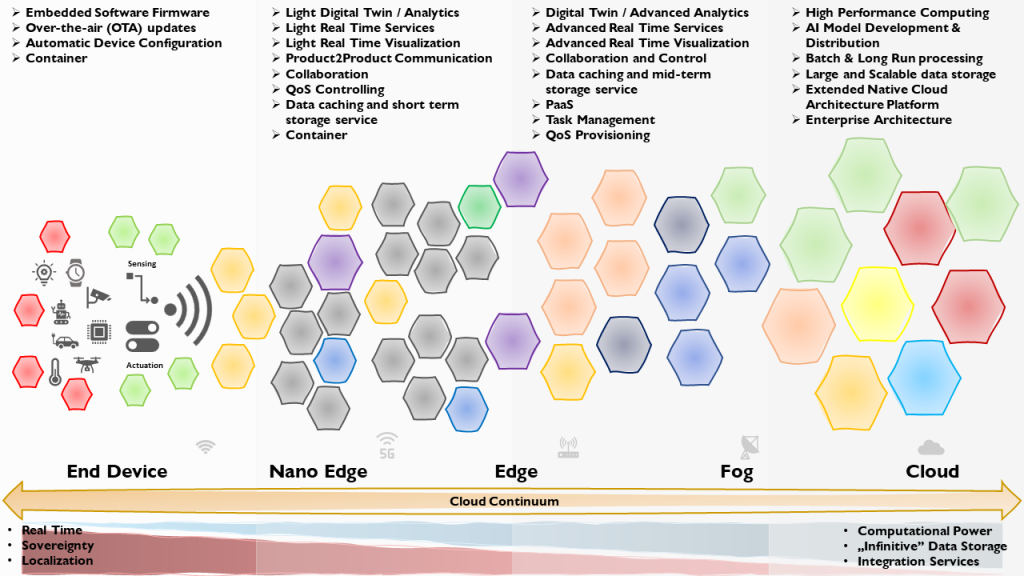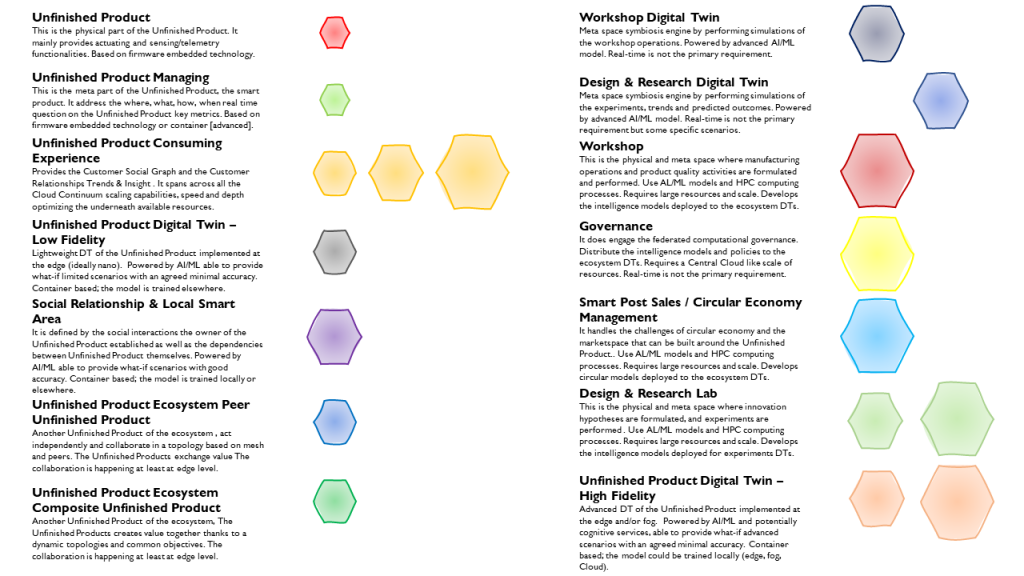Digital Twins technology has been increasingly gaining relevance to support day-by-day operations and innovation simulations. In this article and the companion technical paper[1] we explore, review, and assert scenarios that take Digital Twin to the next level of complexity and how those new challenges could be addressed by distributed architecture. By doing so, we articulate how ,operating in the Cloud Continuum and embracing the Data Mesh principles, Distributed Digital Twin becomes the backbone of Unfinished Products.
Let’s start by taking a step back and defining what a digital twin is. Digital Twins are (physical and/or virtual) machines or computer-based models that are simulating, emulating, mirroring, or ‘‘twinning’’ the life of a physical entity, which may be an object, a process, a human, or a human-related feature[2].
Thanks to Digital Twins, businesses are now more able to predict maintenance opportunities. Optimizing maintenance activities and achieving excellence in performing corrective & preventative maintenance tactics are usually the “where-to-start” approach for business adopting digital twins. Just in time replacement of components enables lengthening the lifecycle of products, reducing unplanned maintenance and labor costs. Digital Twins are helping businesses to manage their bottom line.
Usual implementations of digital twins are based on a centralized big data architecture able to collect data from the real world and centrally process them with Artificial Intelligence. Analytics can derive insight on the real space and, by the virtual space, influencing [or avoiding] potential future behaviors.
The traditional implementation of digital twins implies various challenges as for example: transferring, data, unacceptable latency in accessing insight, high environmental impact, high solutioning costs and low ability in evolving the solution to address new use cases.
We need to look at alternative approaches to create sustainable “Continuous Intelligence to support continuous decisions” solutions. Digital Twins has to be ready to cope with scenarios characterized by a high degree of mobility. Understanding how Digital Twin can effectively guarantee the security & safety when the world they twin is defined by people and assets moving freely, frequently and unpredictably.
Those are all scenarios where Unfinished Products are expected demonstrating their relevance and high performances. The ability to provide “Continuous Intelligence to support continuous decisions” is brought to an exponential level of complexity. The amount of data managed, the speed and variability required, demand “Collaboration” between and within various “Distributed Architected” multiparty systems.
For example, let’s take a look at the challenge of making transportation and cities more sustainable. In making mobility environmental affordable, the industry is pushing adoption of electric vehicles – EVs, autonomous and automated vehicles technology. The success of those new technologies is linked to the ability of creating infrastructure and ecosystems that, on one end are capable to remove blockers on moving out from traditional transportation technologies, and on the other end, enhance the Quality of Service – QoS – and the Quality of Experience – QoE – for drivers, users, and all the citizens.
We could start addressing the challenge by focusing on the Battery’s Pack. Using Digital Twin technology, we can monitor in real‐time and apply intelligence in managing electric vehicles’ batteries so that we can optimize performances and the lifecycle of the batteries and the related EV.
Introducing Digital Twin technology in EV‐Battery Telematics systems could coordinate battery performances and charging stations capabilities so that the tradeoff between demand and supply of electric power is scalable and sustainable. Doing so, Digital Twin technology could help in overcoming the limits of lithium technology representing the current main blocker to mass adoption of EVs.
To make those telematics systems effective, we cannot overlook the social aspects and behavior of their actors. Thanks to Distributed Digital Twin in Cloud Continuum we can create and manage “social-aware smart vehicles” prospects[3] enabling at scale sustainable smart city and mobility. Social-aware smart vehicles, and overall, the social-aware Cloud Continuum, represent innovative tradeoff where “Continuous Intelligence to support continuous decisions” and “Distributed Architecture” are married together. Defining the social relationship model between assets, analyzing those relationship and deriving insight enables Unfinished Products to handle complex and dynamic ecosystems’ relationships.
The above complex relationships are not limited transportation and smart cities. We experience complex and dynamic ecosystems’ relationships when we must handle advanced security & safety scenarios too. For example, Distributed Digital Twin in Cloud Continuum technology become critical in guarantying the security & safety of mining facilities[4] or inspections in hazardous sites[5]. Distributed Digital Twin in Cloud Continuum technology is relevant too for use cases where we continuously need to assess the sustainability of buildings and the wellbeing of people living or working on situ[6]. Or when our goal is to reduce carbon emissions as well as managing the social and environmental impact of proposed large-scale infrastructures[7].
In any of the industries use case, defining the social relationship model between assets, analyzing those relationship and deriving insight is the constant factor that can guarantee the ability to handle complex and dynamic ecosystems’ relationships. Wearable technology plays an important role as wearables represent high personalized device able to augment the human user experience in a connected world. Wearable to wearable (D2D device to device) connections could be based on relationship reflecting social interaction from the people carrying the wearables. We so expect Unfinished Products frameworks to consider wearables as one of the technologies enabling social relationship model between assets.
Information technology has been consistently aiming to improve traditional business, social and educational processes sustainability. That said, one of the aspects we cannot overlook is technology itself requires energy across all its lifecycle. Connected devices and Internet of Things technology is predicted to be about a quarter of the total world-wide energy consumption by 2030[8]. Reduction energy consumption and emissions for wireless sensors is a space for innovation itself. Distributed digital twin is expected to drive intelligent energy-awareness capabilities across all the nodes of the smart ecosystem.
In a smart world, mobility, security & safety as well as user experience evolve continually due to internal and external factors of an ecosystem. The changes in users’ needs, in situational awareness, and in engaged actors, bring additional complexity to our ability to derive insight promptly and to consequentially take effective decisions.
Mobility, defined as “the ability to move or be moved freely and easily”[9] could benefit by continuous intelligence to support continuous decisions so that we can handle the three following subproblems:
- the vehicles, and in general the assets serving the movement experience
- the connectivity and interactions between the vehicles [or mobility actors]
- the Cyber Physical System and in general, the system governing and redistributing across mobility actors, the value created by the mobility experience.
Nowadays mobility solutions must take to consideration scale and size of the population that daily moves within and across cities. To satisfy the need of movement in modern life we cannot anymore rely on obsolete transportation infrastructure and outdated technologies. Global warming and climate concern require scalable and diverse modern technologies to redesign mobility sustainability.
Sustainable mobility will need to be designed around Global Localization business model, where global (or wide areas) principles and economy of scale benefits are continuously adapted with the local and very current unique needs. Inclusion between all the stakeholders and mobility actors contributes effectively to sustainable needs of the movement in modern life’s value chain.
Connected intelligent devices and distributed architecture become critical for guaranteeing security & safety in scenarios where aspect as lack of resiliency and latency could put at risks people lives.
When security & safety is related to humans, we cannot overlook concerns of data sensitivity vulnerability, and confidentiality as well as ethical aspects. Security & safety-oriented technology (e.g. homomorphic encryption[10]) requires higher computation power and storage resources. Security & safety requirements put pressure to distributed architecture nodes characterized by scarcity of resources. Security & safety becomes an important factor in the overall QoS equation.
In managing the experience, we focalize on symbiotic and seamless interactions between machines, humans, and smart environment. Tactile and haptic communications (including touch and motion) wherever initiated by physical or remote interactions should be augmented by easy-to-use human-machine interfaces.
Nowadays, Extended Reality (XR) is the primary technology deployed to shape the user experience and interaction between humans and connected intelligent ecosystems. XR technology is a valid option to facilitate symbiotic interactions between machines and humans. That said, XR technology manifests limitations as: uncomfortable experience for the user when used for long; duration of the batteries; limited strident data and data storage; costs; lack of real-time model generation; and inability to implement situation predictions.
The growing needs of symbiotic interaction between humans & machines is creating the space for new concepts and technologies. “Tactile internet”[11] and “Internet of Skills – IoS”[12], use AI as a critical engine to engage Distributed Digital Twin together with the human-in-the-loop (HITL). Thanks to AI the collaboration and interaction between humans and machines across real, virtual, and remote environments can bring higher QoE.
Social-aware communications, as for example the communications among wearables introduced earlier, lead to the Social Internet of Things (SIoT) concept. SIoT focuses on socially driven collaborations among objects. In SIoT humans and machines come together and share their networks. Doing so, the resulting augmented network enables humans and objects to achieve common goals with consistent and improved QoS.
For example, focusing on vehicles, SIoT defines social-aware vehicular networks. Social-aware vehicular networks can help optimizing the traffic by predicting, anticipating, and better distributing vehicles flow. Social-aware vehicular networks could play a significant role in enhancing security & safety for mobility too. Vehicles as actors of social-aware vehicular networks can be used as bridges between communities or domains. A vehicle, traveling in the closeness of a given community or domain, can facilitate the connectivity (either from an infrastructure or from a data and content perspective) with the domain the vehicle is currently connected to.
As result of those reflections, we propose the “Unfinished Products’ Reference Conceptual Distributed Architecture” exploring concepts as Social Internet of Things (SIoT), leveraging Data Mesh[13] and based on Distributed Digital Twin across an up-to-the-edge Continuum Cloud topology.
The intent is to decentralize and distribute ownership of the decision process to the actors – humans and or machines – who are closest to the where data are generated, and the experience delivered. So that, thanks to the “Distributed Architecture”, we can effectively implement “Continuous Intelligence to support continuous decisions” at scale and at speed.
The distributed architecture nodes are designed as Domain Bounded Contexts[14] able to provide analytical data together with their metadata as well as the computation operational data necessary to serve each single domain.
The suggested reference data ownership model covers the entire spectrum of domains Unfinished Products could handle or be relevant to, from the early stages of Research and Development till the post sales and Circular Economy principles. The data ownership model is harmonized by a federated governance distributing accountability to the various domains and guide them by developing and recommending compliance policies.
Unfinished Products governance model is characterized by global standardization, dynamic topology, and most importantly automated execution of decisions by the platform. This governance model, the federated computational governance, implement the Global Localization approach: data product owners exercise their autonomy and domain-local decision-making power. While doing so data product owners ensure they align with global rules.
Thanks to the federated model, the refence architecture provides a framework where “Continuous Intelligence to support continuous decisions” and “Distributed Architecture” principles, from competing forces become complementary ones.


The proposed Cloud Continuum (visualized above) brings to live distributed architecture principles demonstrating how critical capabilities and workload of Unfinished Products ecosystem can be distributed along the Continuum.
Conclusions
In this article and the companion paper[1] we looked at scenarios that set additional constrains to Digital Twins. We asserted and analyzed how digital twins do and should evolve handling high degree of mobility (human and assets characterized by free and fairly unpredictable movements), guaranteeing the security & safety, and elevating the user experience.
In reviewing and studying the available literature, we concluded that establishing social relationship between intelligent devices, and by applying a federated governance model, we transform the “Continuous Intelligence to support continuous decisions” and “Distributed Architecture” principles from competing forces to complementary ones. Concepts as Social Internet of Things – SIoT – are so crucial in formalizing social aware networks.
Cloud continuum, the relevance of edge computing, and analytics at the edge represent the best lead to scale scenarios characterized by high degree of secure, engaging, and sustainable mobility needs. Thanks to the “Unfinished Products’ Reference Conceptual Distributed Architecture” we propose a framework that pushes the data analysis, ownership and insight toward a federated model embracing Global Localization principles.
This article and the companion paper[1] develop and address the pillars of Unfinished Products[15]. Further work is required to design and eventually implement Unfinished Products ecosystem at large scale. The reviewed literature bring novelty and depth to distributed digital twin view. That said, the research and paper analyzed, or they do not adopt a full Cloud Continuum spectrum, or they do not focus on the entire ecosystems.
Notes
[1] Digital Twin in distributed scenarios – Technical Paper https://www.getrevue.co/profile/mfascinari/issues/digital-twin-in-distributed-scenarios-technical-paper-603612
[2] “B. R. Barricelli, E. Casiraghi and D. Fogli, “A Survey on Digital Twin: Definitions, Characteristics, Applications, and Design Implications,” in IEEE Access, vol. 7, pp. 167653-167671, 2019, doi: 10.1109/ACCESS.2019.2953499.
[3] K. Zhang, J. Cao, S. Maharjan and Y. Zhang, “Digital Twin Empowered Content Caching in Social-Aware Vehicular Edge Networks,” in IEEE Transactions on Computational Social Systems, doi: 10.1109/TCSS.2021.3068369.
[4] Y. Zhang, L. Zhao, K. Yang and L. Xu, “Mobile Edge Computing for Intelligent Mining Safety: A Case Study of Ventilator,” 2020 IEEE Intl Conf on Parallel & Distributed Processing with Applications, Big Data & Cloud Computing, Sustainable Computing & Communications, Social Computing & Networking (ISPA/BDCloud/SocialCom/SustainCom), 2020, pp. 1300-1305, doi: 10.1109/ISPA-BDCloud-SocialCom-SustainCom51426.2020.00192.
[5] D. Mitchell et al., “Symbiotic System of Systems Design for Safe and Resilient Autonomous Robotics in Offshore Wind Farms,” in IEEE Access, vol. 9, pp. 141421-141452, 2021, doi: 10.1109/ACCESS.2021.3117727.
[6] Tagliabue, L.C.; Cecconi, F.R.; Maltese, S.; Rinaldi, S.; Ciribini, A.L.C.; Flammini, A. Leveraging Digital Twin for Sustainability Assessment of an Educational Building. Sustainability 2021, 13, 480. https://doi.org/10.3390/su13020480
[7] Akroyd, Jethro et al. “The National Digital Twin of the UK – a knowledge-graph approach.” (2021). https://www.semanticscholar.org/paper/The-National-Digital-Twin-of-the-UK-%E2%80%93-a-approach-Akroyd-Mosbach/867fa022685c1270f785cc58e3f5b622a1bd37cb Aleksandr Ometov, Viktoriia Shubina, Lucie Klus, Justyna Skibińska, Salwa Saafi, Pavel Pascacio, Laura Flueratoru, Darwin Quezada Gaibor, Nadezhda Chukhno, Olga Chukhno, Asad Ali, Asma Channa, Ekaterina Svertoka, Waleed Bin Qaim, Raúl Casanova-Marqués, Sylvia Holcer, Joaquín Torres-Sospedra, Sven Casteleyn, Giuseppe Ruggeri, Giuseppe Araniti, Radim Burget, Jiri Hosek, Elena Simona Lohan.
[8] Majetta, K.; Bräunig, J.; Sohrmann, C.; Jancke, R. and Mayer, D. (2021). Model-based Systems Design for Green IoT Systems. In Proceedings of the 10th International Conference on Smart Cities and Green ICT Systems – SMARTGREENS, ISBN 978-989-758-512-8; ISSN 2184-4968, pages 204-211. DOI: 10.5220/0010474602040211
[9] Mobility definition (Cambridge Dictionary) – https://dictionary.cambridge.org/dictionary/english/mobility
[10] Homomorphic encryption is a form of encryption that permits users to perform computations on its encrypted data without first decrypting it. These resulting computations are left in an encrypted form which, when decrypted, result in an identical output to that produced had the operations been performed on the unencrypted data. Homomorphic encryption can be used for privacy-preserving outsourced storage and computation. This allows data to be encrypted and out-sourced to commercial cloud environments for processing, all while encrypted. https://en.wikipedia.org/wiki/Homomorphic_encryption
[11] “Tactile internet” was defined by the IEEE P1918.1 [39] as: “A network or network of networks for remotely accessing, perceiving, manipulating or controlling real or virtual objects or processes in perceived real time by humans or machines.” M. Simsek, G. P. Fettweis and C. I, “Tactile Internet [Scanning the Issue],” in Proceedings of the IEEE, vol. 107, no. 2, pp. 253-255, Feb. 2019, doi: 10.1109/JPROC.2019.2892535.
[12] M. Dohler et al., “Internet of skills, where robotics meets AI, 5G and the Tactile Internet,” 2017 European Conference on Networks and Communications (EuCNC), 2017, pp. 1-5, doi: 10.1109/EuCNC.2017.7980645.
[13] Data Mesh Principles and Logical Architecture “Our aspiration to augment and improve every aspect of business and life with data, demands a paradigm shift in how we manage data at scale. While the technology advances of the past decade have addressed the scale of volume of data and data processing compute, they have failed to address scale in other dimensions: changes in the data landscape, proliferation of sources of data, diversity of data use cases and users, and speed of response to change. Data mesh addresses these dimensions, founded in four principles: domain-oriented decentralized data ownership and architecture, data as a product, self-serve data infrastructure as a platform, and federated computational governance. Each principle drives a new logical view of the technical architecture and organizational structure”. https://martinfowler.com/articles/data-mesh-principles.html
[14] Domain model is a conceptual model based on the domain and includes both behaviors and data. It represents a part of the overall solution that fulfills the goals of the business. Bounded contexts are a pattern in DDD that represent partitions in the domain model. Similar to subdomains, which are partitions in the domain, bounded contexts are partitions in the domain model. As is the case with subdomains, creating partitions and boundaries reduces the overall complexity. https://www.oreilly.com/library/view/software-architects-handbook/9781788624060/d5f9bc57-f27e-4e9c-85f6-0254fbb5e293.xhtml
[15] “A conversation around the Sustainable Development Goals and Unfinished-Products”;https://unfinished-products.com/2021/04/24/a-conversation-around-the-sustainable-development-goals-and-unfinished-products/

Leave a comment